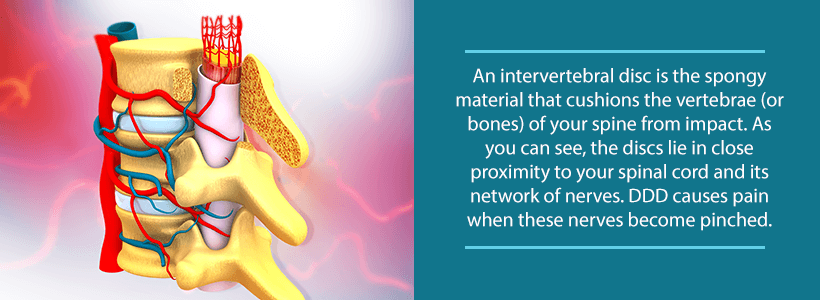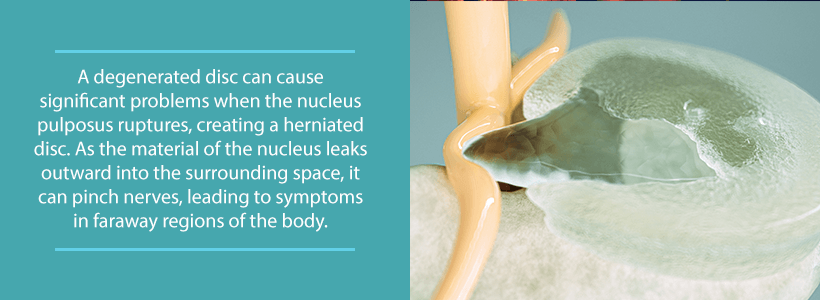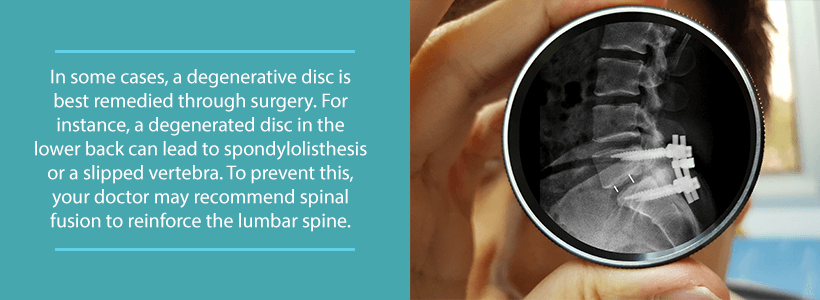If you’re dealing with frequent back or neck pain, your posture might be playing a bigger role than you think. Whether you're sitting at a desk all day or scrolling on your phone for hours,…
Are you suffering from neck or back pain? Has your doctor indicated that your pain may be related to discs in your spine? If so, you’re likely wondering: What degenerative disc treatments are best for me?
You’ve probably been pouring over articles (just like this one!) on the internet about it. Maybe well-intentioned friends and family have even offered some good (or even possibly bad) advice.
Of course, the best treatment for you depends on your condition. For example, how severe is the damage? What part of the spine (cervical, thoracic, or lumbar) is affected? And, are any nerves malfunctioning as a result? Believe it or not, irritated nerve tissue (and not the disc itself) causes the pain associated with degenerative disc disease.
But before we dive more fully into treatments, let’s take a closer look at intervertebral discs themselves and how they might become damaged. Understanding the cause of your problem will empower you to make the most informed decision about your healthcare.
What is Degenerative Disc Disease?
Between each bone of the spine (or vertebra) lies a rubbery, circular disc that resembles a tire. Intervertebral discs consist of a tough outer layer known as the annulus fibrosus. Inside, the disc you will find a jelly-like substance referred to as the nucleus pulposus.
What do these discs do other than mimic a jelly donut in appearance?
These structures act as shock absorbers. Every time you walk, move, or even sit, your discs keep the vertebrae from rubbing against each other. They also protect the spinal cord—the superhighway of nerves connecting the brain to the rest of your body—from irreversible insult. Since these discs maintain spinal structure, they also function to protect nerves that exit through openings in the vertebrae.
Over time, however, these discs can lose their shape. The outer layer begins to deteriorate, which changes the structure of both individual discs and the spine as a whole. These changes often apply pressure on the spinal cord and adjacent nerves, causing pain and other neurological symptoms.
Unfortunately, discs (like most cartilaginous structures) receive only a weak blood supply. This means that once injured, they cannot repair themselves like other tissues in the body. The gradual breakdown of intervertebral discs is known as degenerative disc disease (DDD).
But wait: Is DDD an actual disease?
The name of this condition may be confusing. DDD is not a disease. Instead, it is a description of a set of symptoms that cause pain. So how do you know if you have degenerative disc disease? Review the warning signs below to find out!
Degenerative Disc Disease Symptoms
The spine (with its system of nerves) is a complex structure that runs through most of your body. Depending on the location and severity of your disc issues, you may experience a variety of symptoms. Although disc problems commonly occur in the lower back and neck, your mid-back can also be affected.
Degenerative disc disease symptoms may include:
- Pain in the neck or back that ranges from nagging to disabling
- Back pain that radiates into the buttocks or thighs
- Neck pain that radiates through the arms and hands
- Increased pain while sitting
- Worsening pain while twisting, lifting, or bending
- Periods of severe pain that come and go—sometimes lasting up to a few months
- Tingling or numbness in the arms and hands and/or legs and feet
- Pain that abates while walking or moving
- You feel better when changing positions or lying down
- Weakness in the leg muscles or foot
Degenerative disc disease treatments can ease these symptoms. Seeking successful treatment, however, means understanding the underlying causes of degenerative disc disease.
Degenerative Disc Disease Causes
As mentioned earlier, DDD isn’t an actual disease. It’s a label applied to a disc that has lost its structural integrity and causes pain. This can occur for a variety of reasons.
For many, the primary culprit is the effects of aging. At birth, these discs are about 80% water. As the years pass, discs tend to dry out and lose their ability to absorb shock effectively.
Likewise, participation in certain sports and activities can cause disc breakdown. Unfortunately, contact sports and other physically demanding activities may eventually take their toll on your spine. In time, the discs may weaken, flatten, or break down as they struggle to withstand the shock.
Sudden trauma or injuries may also adversely alter a disc’s structure. Car accidents or sudden falls may cause the disc’s inner layer (the nucleus pulposus) to break through the damaged outer layer. Known as a bulging or herniated disc, this can apply pressure on nearby nerve roots or even on the spinal cord itself.
What are some risk factors that contribute to degenerative disc disease?
- Smoking
- Occupations that involve heavy lifting
- Participating in contact sports
- Obesity
- Sudden injuries that affect the spine
- A family history of back pain or musculoskeletal disorders
- Weak core muscles
- Poor posture
- Occupations or activities that involve prolonged sitting
Now that you have a better understanding of the discs and how they may become injured, let’s look at some degenerative disc disease treatments.
Degenerative Disc Disease Treatments You Should Know About
Once it’s been determined that you’re dealing with degenerative disc disease, you’ll want to know what treatments are available.
There are several degenerative disc disease treatments, ranging from conservative to surgical. Treatment goals include decreasing or eliminating pain, making the spine more stable, and maintaining or improving mobility in the affected areas.
Oftentimes, a combination of treatments can be used to achieve these goals. Finding an orthopedic doctor who collaborates with different disciplines may be the most effective method of treating your degenerative disc disease symptoms.
Ready to learn about treatments? We thought so.
Non-Surgical Degenerative Disc Disease Treatments
Most people start with more conservative treatments to manage their pain. These approaches often include:
Medications
If you’re dealing with mild to moderate pain, over-the-counter medications may be effective. This includes nonsteroidal anti-inflammatory drugs (NSAIDs) like aspirin or ibuprofen. These drugs block the enzymes that promote inflammation. As a result, pain and inflammation are reduced. In addition, over-the-counter acetaminophen interferes with the pain signals sent to the brain.
Those who are dealing with more severe pain, however, may need even more powerful medications. Prescription pain medications like muscle relaxants or narcotic painkillers can ease intense, short-term pain. Be warned: Some of these medications can be habit-forming. Take them exactly as prescribed. Those with a history of substance abuse or addiction may need to use extra caution if prescribed these drugs.
Hot and Cold Therapy
Those with mild pain may find applying heat or cold to the area to be an effective form of pain relief. Applying ice packs during pain flare-ups can reduce inflammation and numb the area. Heating pads or packs, on the other hand, relax the muscles and improve circulation to the area. This added circulation may accelerate the healing process.
Changes to Your Lifestyle
As mentioned earlier, there are some lifestyle choices that may be contributing to your degenerative disc disease pain. Obtaining the proper amount of exercise can promote health and strengthen affected muscles. A healthy diet can make you feel better and reduce inflammation in the body. And, quitting smoking or using other tobacco products may slow down the rate of disc degradation.
Massage Therapy
A licensed massage therapist has an intimate knowledge of musculoskeletal conditions. He or she learns techniques that assist in reducing tension in the neck and lower back. In addition, a massage can ease pressure on the spine and increase blood flow to the area. Muscle spasms related to changes in the structure of the spine can also be alleviated with a massage.
Physical Therapy
A physical therapist plays several roles in degenerative disc disease treatment. After a thorough evaluation, a physical therapist creates an individualized treatment plan based on your symptoms and condition. These plans often include manual manipulation as well as prescribed exercises to stretch and strengthen the affected areas. Changes in the spine can affect a variety of muscles in the back or neck. Degenerative disc disease exercises to target specific muscles affected by your injured discs. Following a prescribed exercise routine can reduce pain as well as increase your mobility.
Also, a physical therapist can suggest changes to your daily activities that reduce painful flare-ups. You may also receive ideas for adaptive equipment like ergonomic chairs or back braces that can provide daily relief.
Therapeutic Injections
If oral medications and physical therapy don’t seem to be helping, a therapeutic injection may be your next step. Injections allow doctors to deliver medicine directly to the source of pain. Therapeutic injections don’t correct structural issues in the spine, however. They are limited in that one respect. These injections can, nevertheless, allow you to live pain-free for weeks or even months at a time. Common therapeutic injections include epidurals, nerve blocks, trigger point injections, or facet joint injections.
Surgical Degenerative Disc Disease Treatments
Before we get into surgical treatments, there is something else you should know.
Most people don’t need surgery for degenerative disc disease. Many people can achieve pain relief using the degenerative disc disease treatments described above. If these treatments don’t seem to help after several months, however, then surgery may be recommended.
So what happens during degenerative disc disease surgery?
This often depends on how badly your discs are damaged, what nerves are affected, and the structural damage to your spine.
Some surgical procedures to repair changes from degenerative disc disease include:
- Discectomy: Removing part of the disc that presses on an inflamed nerve. Sometimes this can be performed as a minimally invasive microdiscectomy.
- Spinal Fusion: After a disc is removed, the surgeon may need to place bone grafts and other instrumentation in the disc space so the spinal bones can fuse together. This will increase the stability of the spine.
- Artificial Disc Replacement: The surgeon inserts a prosthetic spacer in place of a removed disc. This can be a great alternative to spinal fusion surgery, especially for younger patients. Artificial disc replacement allows more flexibility in the spine compared to spinal fusion.
Thanks to advancing medical technology, some of these surgeries can be performed as minimally invasive procedures.
What does this mean for you?
Minimally invasive procedures offer several benefits including:
- Smaller scars
- Less damage to surrounding tissue
- Reduced postoperative pain
- Quicker recovery times
- Less reliance on narcotic pain medications
- The ability to return home after surgery sooner
What Degenerative Disc Treatment is Right for You?
Do you want to know how to find the best treatment? Schedule a consultation with an orthopedic doctor who specializes in issues related to degenerative disc disease.
Not sure where to turn? Orthopedic & Laser Spine Surgery has a team of professionals who specialize in both conservative and surgical options for treating degenerative disc disease.
Have you tried some of these treatments without success? Sometimes, all you need is a second opinion on how to best treat your pain. If you’ve undergone any recent diagnostic tests, you could easily and securely send us those results online. Our orthopedic specialists will take a look at them and give you a second opinion as well as treatment recommendations.
Let us help you regain control of your life. By filling out a simple survey on our website, you can get started on your path to recovery today!





